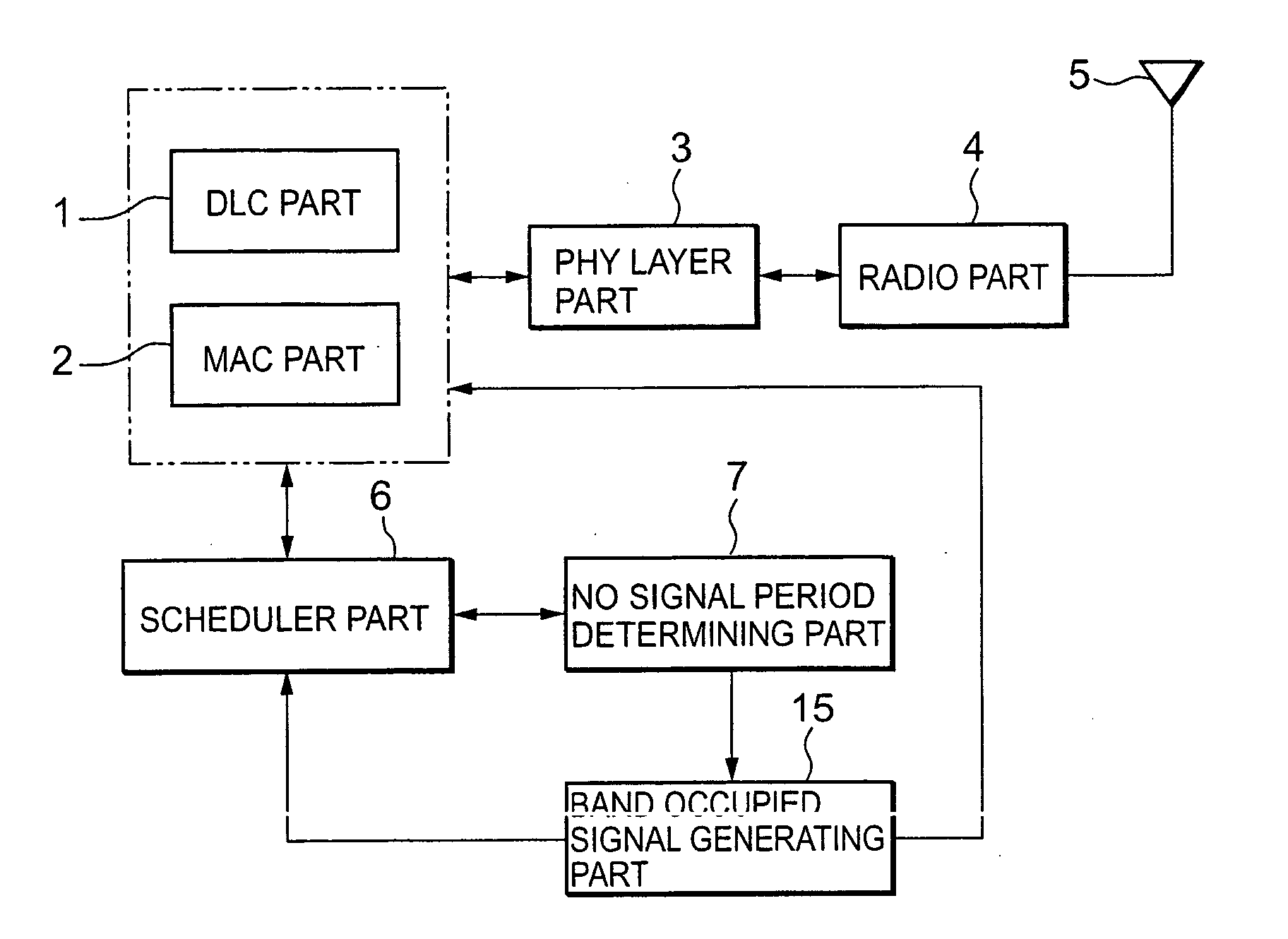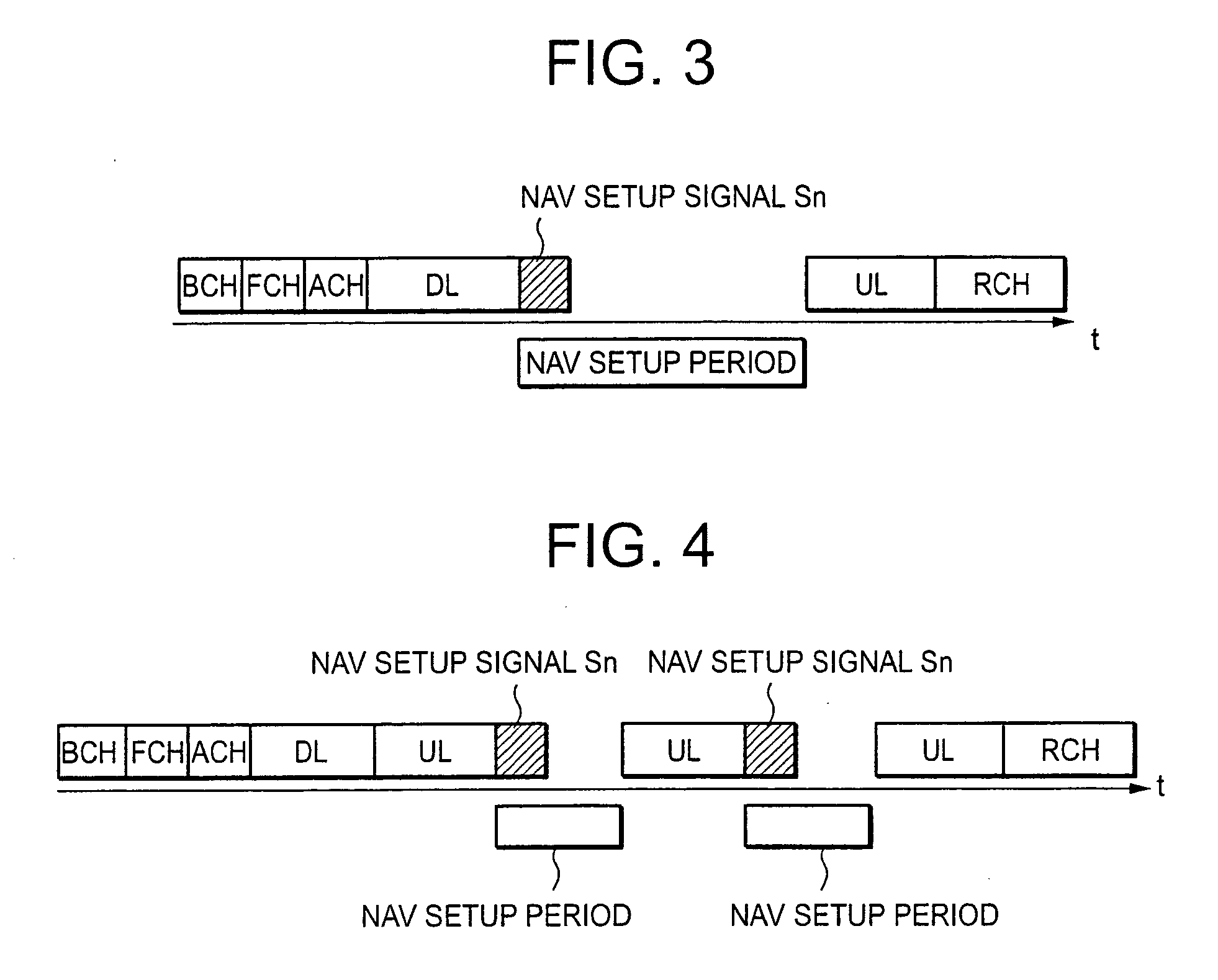Radio lan system and radio lan system signal collision evading method
a radio lan system and radio lan technology, applied in the field of wireless lan communications, can solve the problems of difficult to use mixed wireless lan systems based on these different standards
- Summary
- Abstract
- Description
- Claims
- Application Information
AI Technical Summary
Benefits of technology
Problems solved by technology
Method used
Image
Examples
first embodiment
[0058] (First Embodiment)
[0059] FIG. 1 is a block diagram showing a configuration of an access point in a wireless LAN system according to the first embodiment of the present invention.
[0060] In FIG. 1, the access point in the wireless LAN system according to the embodiment includes a DLC part (hereinbelow called the data link part) 1, a MAC part (hereinbelow called the medium access part) 2, a PHY (Physical Layer Protocol) layer part 3, a radio part 4, an antenna 5, a scheduler part 6, a no signal period determining part 7, and a NAV setup signal generating part 8.
[0061] The data link part 1 controls the transmission of data, and has three processing phases: connection establishment, data transfer, and data link connection release. The medium access part 2 controls the way of transmitting data to a LAN cable (medium) and the like. The PHY layer part 3 interconverts data to be exchanged and signals according to the channel, and outputs the converted data. The radio part 4 converts t...
second embodiment
[0070] (Second Embodiment)
[0071] Since the access point in the wireless LAN system according to the second embodiment of the present invention has the same configuration as that according to the first embodiment, the illustration of the configuration will be omitted, using FIG. 1 or FIG. 2 as needed.
[0072] FIG. 4 is a diagram showing the arrangement of data upon scheduling of a communication frame at the access point in the wireless LAN system according to the second embodiment of the present invention.
[0073] Upon scheduling of a communication frame, when informed from the no signal period determining part 7 that a no signal section has occurred between two adjacent uplink phases, which come before or after each other in time sequence, the scheduler part 6 puts a NAV setup signal Sn behind the preceding uplink phase, in accordance with instructions from the NAV setup signal generating part 8, as channel reservation data that covers the no signal section. The two adjacent uplink phas...
third embodiment
[0076] (Third Embodiment)
[0077] Since the access point in the wireless LAN system according to the third embodiment of the present invention has the same configuration as that according to the first embodiment, the illustration of the configuration will be omitted, using FIG. 1 or FIG. 2 as needed.
[0078] FIG. 5 is a diagram showing the arrangement of data upon scheduling of a communication frame at the access point in the wireless LAN system according to the third embodiment of the present invention.
[0079] Upon scheduling of a communication frame, when informed from the no signal period determining part 7 that a no signal section has occurred between a downlink phase and an uplink phase, the scheduler part 6 performs scheduling as follows. That is, when the no signal section is longer than the carrier sense time of a station in an IEEE802.11a wireless LAN system, the scheduler part 6 puts a NAV setup signal Sn between the downlink phase and the uplink phase prior to the success of c...
PUM
 Login to View More
Login to View More Abstract
Description
Claims
Application Information
 Login to View More
Login to View More - R&D
- Intellectual Property
- Life Sciences
- Materials
- Tech Scout
- Unparalleled Data Quality
- Higher Quality Content
- 60% Fewer Hallucinations
Browse by: Latest US Patents, China's latest patents, Technical Efficacy Thesaurus, Application Domain, Technology Topic, Popular Technical Reports.
© 2025 PatSnap. All rights reserved.Legal|Privacy policy|Modern Slavery Act Transparency Statement|Sitemap|About US| Contact US: help@patsnap.com



